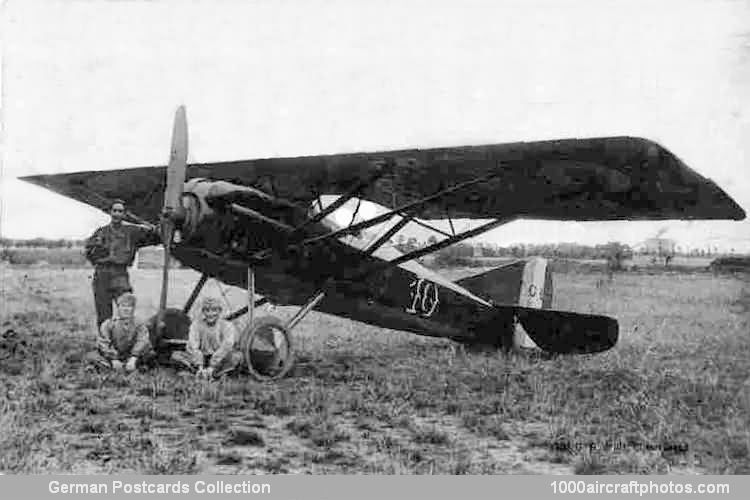07/31/2018. Remarks by Johan Visschedijk: "In 1916 Charles E. P. Gourdou and Jean A. Leseurre worked on ways of reducing aircraft drag, and eventually encapsulated their findings in a patent filed January 9, 1917, describing a parasol-winged fighter. An order from Aviation Militaire followed, and the GL-1 (also known as the Type A) was built by Société Wassmer, who normally made propellers.
The GL-1 was a single-seat parasol monoplane fighter powered by a 180 hp Hispano-Suiza 8Ab eight-cylinder liquid-cooled engine. Of mixed construction, with an all-metal fuselage primarily of steel tube with plywood covering and a fabric covered wing with steel spars and wooden ribs, the GL-1 was officially evaluated at the French military test center at Villacoublay on May 10, 1918. Structurally overweight, the prototype was tested with one of its two 0.303 in (7.7 mm) Vickers machine guns removed and with reduced fuel. It demonstrated in this configuration level speeds higher than contemporary fighters powered by a 300 hp Hispano-Suiza engine. Although the design team believed that the structural weight problem could be resolved, official testing indicated that the wing had insufficient strength, and redesign was therefore undertaken to result in the GL-2.
The GL-2 (alias Type B) had, by comparison with its progenitor GL-1, an entirely new and heavily reinforced wing, new horizontal tail surfaces mounted higher on the rear fuselage, and revised rudder and landing gear. The H.S. 8Ab engine and twin Vickers machine guns were retained. The number of pairs of inclined wing bracing struts was increased from two to four, one pair attaching to the wing at half-span and another at three-quarter-span, the cantilevered portion thus being only one-quarter of the half-span. This resulted in an extremely rigid structure, the wing load factor being 10.4 compared with 3.5 for the GL-1.
Twenty GL-2s were ordered for the Aéronautique Militaire and built by Mayen et Zodiac. The first was delivered to Villacoublay in late November 1918. Subsequent aircraft were fitted with a taller rudder and enlarged fin to rectify a directional control deficiency, but with the termination of hostilities, Aéronautique Militaire interest in the GL-2 waned, an order for an additional 100 aircraft was cancelled.
With the end of WW I, Gourdou and Leseurre established their own company at Saint-Maur-des-Fossés, and designed a succession of fighters, trainers, reconnaissance aircraft and racers.
The GL-21 (Type B2) was a development of the GL-2 fighter monoplane, also was powered by the H.S. 8Ab, but the broad chord ailerons with their horn-balance areas lying within the wing planform were replaced by longer-span and narrower constant chord ailerons. The rudder was enlarged and the series model introduced additional landing gear bracing struts. Armament comprised twin Vickers machine guns in the fuselage.
The prototype GL-21 was exhibited at the Paris Salon de l'Aéronautique of 1920, and subsequently twenty examples were delivered to the French AF. A single one was delivered to Finland in 1923. A total of 30 single-seat fighters of this type was built.
The GL-22 (Type B3), evolved in parallel with the GL-21, also made its debut in 1920. It differed from the GL-21 primarily in having a new wing profile, steel-tube in place of light alloy wing bracing struts, a modified frontal radiator and a revised cockpit interior. The H.S. 8Ab and twin Vickers machine guns were retained, but some structural revision reduced empty weight by 154 lb (70 kg). The prototype, like that of the GL-21, was initially flown with twin landing gear struts on each side, but a triple-strut arrangement was adopted for the series model.
With gun armament the aircraft was designated GL-22 C1 (C = Chasse), but without armament it was designated GL-22 ET1 (ET = Entrainement de Transition) and was intended for the advanced training role. On December 13, 1920, the first order for the GL-22 was placed with Gourdou-Leseurre, and subsequently eighteen single-seat fighters were built for Finland and fifteen each for Czechoslovakia and Estonia. Thirty of the training version being supplied to the French Navy and three to the civil market. In Finland an additional aircraft was later being assembled from spares. The newly-established Zmaj concern in Yugoslavia acquired a manufacturing license.
The GL-23 (Type B4) single-seat fighter of 1925 was the last development of the basic GL-2 design. The H.S. 8Ab engine and standard GL-22 C1 fuselage and armament were mated with the longer span wing and enlarged rudder first applied to the experimental tandem two-seat GL-22 ET2 (Type B5) trainer of 1922. A total of nine GL-23 C1 aircraft was built at St. Maur, two of these having different wing profiles for comparison purposes. One example had its fuselage elongated by 25.6 in (65 cm) to provide for accommodation of a single casualty stretcher aft of the pilot. This was presented at the Paris Salon at Le Bourget on April 24, 1925 as the GL-23 TS, one other example being completed (as the LGL 23 TS) in the following year."
